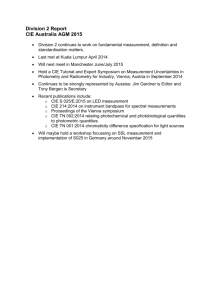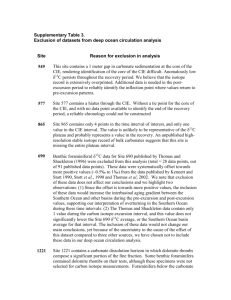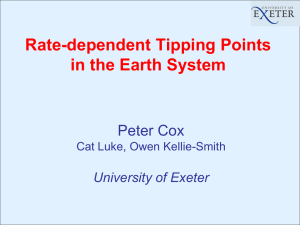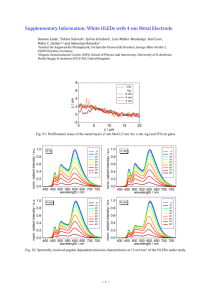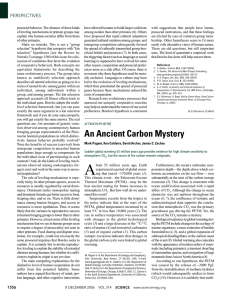The Palaeocene-Eocene thermal maximum: anatomy of a tipping point
advertisement
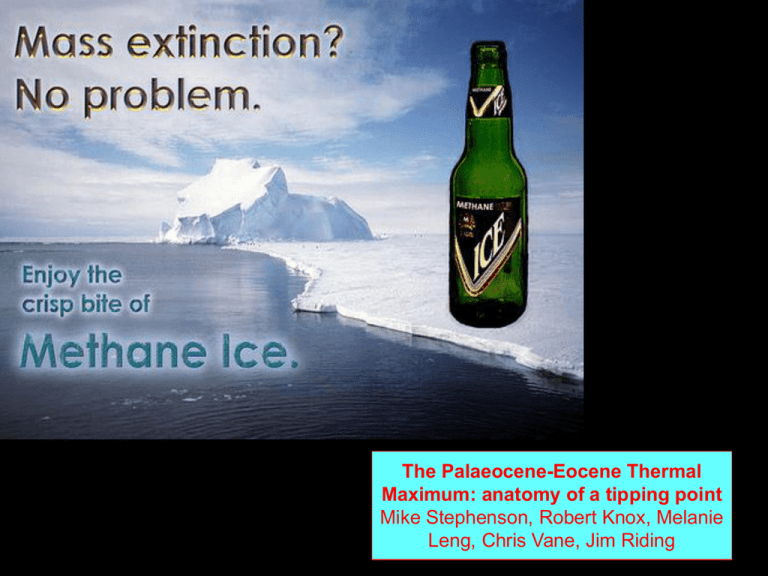
The Palaeocene-Eocene Thermal Maximum: anatomy of a tipping point Mike Stephenson, Robert Knox, Melanie Leng, Chris Vane, Jim Riding Tipping point • point at which a slow gradual change becomes irreversible and then proceeds with gathering pace • point in the evolution of the earth's climate leading to irreversible change • When a small (unnoticed) thing happens which is enough to precipitate huge things happening….which we can’t repair Is the climate tipping? • Some scientists e.g. James Hansen, tipping point already reached – CO2 at 385 ppm • Some say - tipping point difficult to predict for non-linear, complex system • Some say - political slogan - instil fear in policy makers and largesse in science funders Can we stop the tipping? • Man made global warming - changing the composition of atmosphere by emission of carbon dioxide and methane. • Remedial action - reduce greenhouse gas. • Is this a reasonable assumption? Research: understand tipping point • rates of change in biogeochemical cycles • change in extreme events not seen in the last 10k yrs • negative feedbacks that bring the system back to normal dynamic equilibrium Palaeocene-Eocene Thermal maximum: natural laboratory Palaeocene-Eocene Thermal Maximum: why it’s important • NOW – injection CO2 into atmosphere. – changes predicted extreme, 5.6° C increase in the next one hundred years – CO2 atmospheric concentrations higher than at any time during the Quaternary. • PETM – similar magnitude CO2 and temperature increase – some of the remnants of the changes are preserved in the rocks. • Comparison follows Comparison: CO2 • Drax B - 7% of England's electricity; lifetime emission 1 Gt • China emissions 3 Gt/yr • Leman Sandstone Formation 3Gt storage capacity • Bunter Sandstone Formation 15 Gt • PETM caused by 1500 Gt of methane carbon from decomposing gas-hydrate reservoirs (Sluijs 2006) • PETM ~ equivalent of 4-8 times the anthropogenic carbon released since start of the industrial era What is preserved? Clay Layer Rocks/lithofacies Forams Dinoflagellates Various geochemical evidence What does it suggest? Temperature increase • TEX86 palaeothermometer • O isotope excursions in foram calcite and terrestrial carbonates • Increased Mg/Ca value in forams • Poleward migrations of tropical marine plankton, terrestrial plants, and mammal migrations Carbon cycle change • 2.5 – 6 ‰ carbon isotope excursion • Believed to represent rapid injection of 13C depleted carbon into the global carbon pool • Conjunction of warming and excursion: greenhouse gas cause? What does the CIE excursion look like? high low Gradual recovery Steep beginning Bass River, Sluijs (2006) warm phytoplanton temp rise Apectodinium peak and temperature rise (as indicated by TEX86) preceded the CIE Did heating trigger methane hydrate release leading to the CIE? Fig. 2 High resolution records across the onset of the PETM at Bass River, New Jersey. BC = bulk carbonate, DINO = dinocysts, VPDB = Vienna Pee Dee Belimnite, mbs = meters below surface. Scales at TEX86 temperatures represent calibrations by Schouten et al. (2002) for the top bar and by (Schouten et al. (2003) for the lower bar. both precede the CIE Only biogenic methane (C = 70‰ enough to create a CIE of this size BP Well 22/10a-4 Middle of N. Sea Well 22-10a/4 • North Sea well - probably the most expanded section known – chance to unravel the CIE • δ13Corg • Palynology/palynofacies • Detailed lithofacies • Organic geochemistry • Inorganic geochemistry
